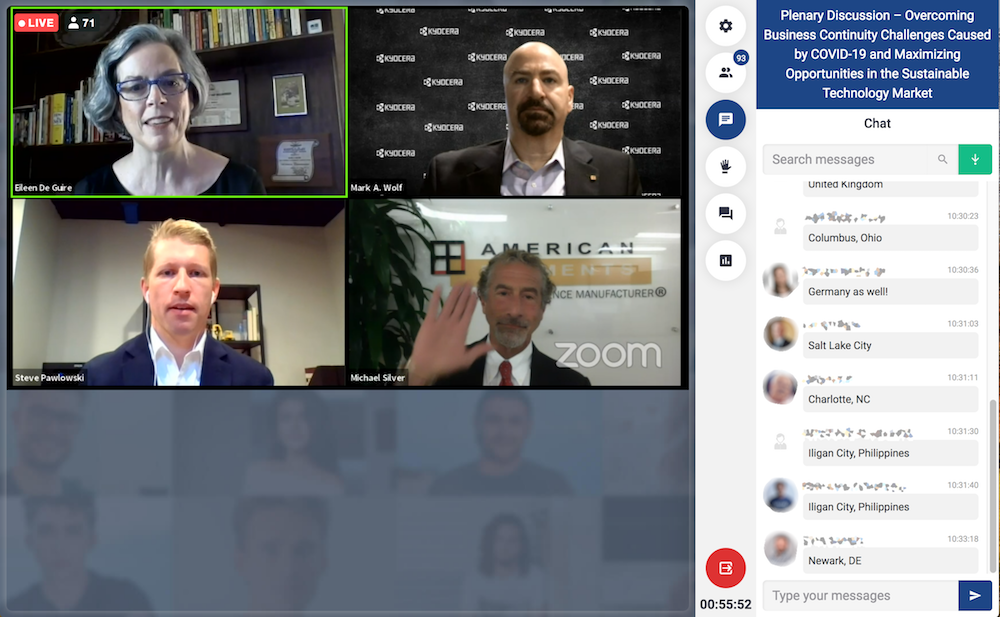
[Image above] ACerS director of technical content and communications Eileen De Guire (top left) moderates the first panel of Ceramics Expo Connect on Sept. 21, 2020. From top right clockwise, the panelists include Kyocera vice president of the fine ceramics group Mark Wolf, American Elements CEO Michael Silver, and CoorsTek director of automotive strategy Steve Pawlowski. Credit: Smarter Shows
When quarantines first started taking effect in March, ceramic and glass industries scrambled to confront the unexpected halt in activities. Now that six months have passed, how are manufacturers handling the pandemic today?
That question was at the core of many discussions last week at Ceramics Expo Connect, the virtual version of Ceramics Expo. The industry exposition, which typically takes place in the spring, took place September 21–25 instead, and it welcomed more than 1,500 virtual event attendees and more than 150 exhibitors.
Each day of the exposition featured panels, interviews, and roundtables focused on different themes, including clean and electrified technology (Monday), additive manufacturing (Tuesday), aerospace applications (Wednesday), and quality and testing (Thursday).
The exposition kicked off Monday with a panel on overcoming business continuity challenges caused by COVID-19, moderated by ACerS director of technical content and communications Eileen De Guire. The manufacturers on the panel say while there are still difficulties, overall some of the necessary workarounds enacted to handle the pandemic could prove useful in the future, such as facilitating business electronically and working from home.
They also emphasized that they expect ceramics to play a large role in future sustainable technologies market, such as solid oxide fuel cells and carbon sequestration, especially once a vaccine comes out and the “pent-up demand” is released.
“I think the industry is waking up to the possibilities of ceramics in those applications,” Kyocera vice president of the fine ceramics group Mark Wolf says.
On Tuesday, manufacturers again were future focused in their discussions of additive manufacturing. However, they did caution that AM should not be treated as a solution to all processing challenges.
“We’re just another forming process,” Lithoz America vice president Shawn Allan says. As such, manufacturers need to understand the limitations of AM and build an “increased awareness” of this forming technique.
In line with this way of thinking, panelists also say it would be better for AM to meet the standards already out there for technical ceramics rather than creating a whole new set.
With all the talk of future potential, Wednesday discussions focused on one area in which ceramics are already making a difference: aerospace.
The first jet engines based on ceramic matrix composites were commercially deployed in 2016, and panelists suggested more aerospace opportunities for ceramic materials in the future, including in shrouds, liners, nozzles, and blades. Though the use of ceramics in aerospace applications was once thought impossible, “You better watch out for those pigs because ceramics are flying,” GE Aviation ceramic matrix composites and coatings section leader Jonathon Blank says.
In contrast to the other three days, Thursday wrapped up the exposition with a focus on current processes and how to ensure material quality and testing. Experts from multiple fields offered their expertise, including representatives from vehicle manufacturing, scientific instruments for molecular research, and clay brick making.
Overall, “Ceramics Expo-Connect was a great opportunity to learn what’s new and what’s on the horizon for ceramics across a wide range of applications,” De Guire says.
Ceramics Expo 2021 is currently scheduled for May 3–5, 2021, in Cleveland, Ohio. Stay up to date on the latest plans at www.ceramicsexpousa.com.
